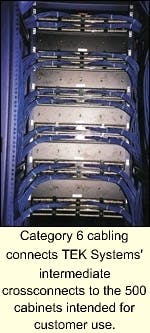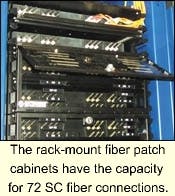Redundant systems allow ASP to offer power, pipe, ping, and ports
An application service provider implements designed-in redundancy to ensure service uptime.
Have you ever tried to dial in from the road to check e-mail, only to be frustrated by a warning stating "The server is not responding"? That frustration, along with the high cost of networking equipment and staffing, has prompted many in-house information-technology departments to outsource. "The outsource model is a feasible economy of scale to provide the latest networking applications, Web hosting, e-mail, and data storage to allow companies to have a high-speed network, maintained 7-24-365, without the cost or the headache," says Nathaniel Hein, operations and support services manager with TEK Systems (Hanover, MD; www.teksystems.com).
"The nature of technology changes in under a year, so if companies can get the fastest connection to the outside world with the most comprehensive LAN [local area network] system to handle the high speeds and bandwidth applications of today and tomorrow, then that's a competitive advantage," Hein adds. "In other words, we provide the power, pipe, and ping. But the key to success of our ASP is the unique design of our redundant networking systems to provide a failsafe environment for our customers, and the NetClear enhanced high-performance Category 6 structured cabling system," he emphasizes. NetClear is an enhanced structured cabling solution, which is an alliance between Berk-Tek (New Holland, PA; www.berktek.com) and Ortronics Inc. (New London, CT; www.ortronics.com).
The design for TEK Systems' ASP center in Portland, OR was the culmination of plans from Applied Technology Solutions (Baltimore, MD; www.atsolution.com) and NetsWork Inc.'s (www.netsworkinc.com) Portland branch office. NetsWork is a network integration, infrastructure, and telephony company, and is an Ortronics Certified Installer
Plus (CIP). Says Eric Maxfield, a consultant with Applied Tech-nology Solutions, "I had de-signed the first data center for the corporate offices of TEK Systems Internet Business Systems, where we utilized redundant systems. But this was a unique location, as we were not installing an internal system, but a failsafe environment for outside hosting."
Essential design feature
"Redundancy is not overkill in this environment, but rather a necessary design feature," he explains. To make a near-failsafe networking system, Applied Technology Solutions designed four separate cabling infrastructures within TEK Systems. Two data paths, called Production 1 and Production 2, lead to a single server. The duplication of data paths provides redundancy for protection against system failure, and also provides a choice for the quickest available data path in the event that one becomes overloaded. The third cabling system, known as an out-of-band management system, is intended to manage servers and network hardware on a discrete Ethernet channel. The fourth system is designed for storage, linking each server to a remote tape backup system.
With four diverse cabling systems and the capability to house 4,000 servers, TEK Systems required a reliable, high-performing structured cabling solution. NetsWork project manager Jon Vining says his workforce's level of training, technical knowledge, and proactive problem resolution let it meet the project's aggressive timeframe. He also credits state-of-the-art design and implementation capabilities with ensuring that customers' networks function as designed.
Maxfield recommended the NetClear system based on previous experience. "We had installed this system in other locations because of the ease of installation and reliability of their combined precision-matched components," he says. He recommended NetClear GT2 for the TEK Systems installation, in part because it promises a channel capacity of 2.5 Gbits/sec and a useable bandwidth of 250 MHz.
"Portland, known as the Silicon Forest, was chosen to be our first site because it poses no geographical threat," explains Hein. "We have no major natural disasters here, such as earthquakes, floods, or landslides. Our business is to fully utilize and fill up this ASP center, and we will evolve as we go along."
"We sell more than just bandwidth," he continues. "Our data center can become an entire network for some companies, since we provide applications as well as Web-hosting capabilities. Our primary focus is messaging and hosting. We can put in Exchange servers and run thousands of clients, and even multiple companies, on a single server. We have enough space for several thousand servers, so we can do a lot in the messaging and hosting arena alone.
"Data centers typically offer the environmental aspects, four walls, and a security person. Most data centers are huge areas of raised-floor space; customers come in and get a chunk of it, cage it off, and utilize the provided cabling infrastructure. But that doesn't mean they can't get hacked into, because they don't have control of the equipment or the software," he explains. "We invested a lot of money to build the best facility to offer 99.999% uptime. We provide not only the racks, security, connectivity, and cabling, but also application support and unlimited bandwidth. With the NetClear solution, we can ensure our customers' future applications and easy network changes."
Anti-crosstalk tecnology
Maxfield adds, "Another key component you need to consider when designing a system to ensure channel capacity and throughput consistently and reliably is the patch cord." Ortronics incorporates a plug design called Paralign in its GigaMo+ patch cord. The technology provides wire-pair control within the standard 8-pin modular plugs, thereby reducing near-end and far-end crosstalk. The cord also offers strain relief and pair balancing to the point of termination.
TEK Systems has the capacity to house more than 500 enclosures, each supported by dual power feeds and with a connection to each of the four networks. A main crossconnect (MC) serves 27 intermediate crossconnects (ICs), and is linked to the ICs via 24-fiber GIGAlite fiber cable containing 62.5/125-micron multimode fibers.
The fiber backbone is terminated to Ormmac II rack-mount fiber patch cabinets, containing 72 SC connections. Circuits are then patched to four GigaMo+ 48-port Category 6 patch panels in each IC-one patch panel for each of the four cabling systems.
From the ICs, Berk-Tek's LANmark-1000 Category 6 cables run to the 500 cabinets set up for TEK Systems' customers. Each customer cabinet includes 24-port Category 6 patch panels.
Within each IC are four distinct termination locations-one for each cabling system. In addition to redundant cable lines, TEK Systems incorporated a redundant power system, including an uninterruptible power supply and a generator for both electrical power and air conditioning.
Rounding out the equipment-protection plan is a 24-hour staff and hotline help desk. "We have a dedicated conference room, called our critical situation room, for managing complex issues," Hein states. "If something goes wrong for a customer, we put together a team to manage and correct it as soon as possible."
Pipe to the outside
The pipe, or connection, to the outside world includes multiple OC-3 lines, which connect to a broader OC-48 Synchronous Optical Network (SONET) ring. "Picture the OC-48 as a virtual ring or superhighway circulating around the country and connecting all the states," explains Maxfield. "Any customer that comes online connects to the ring with a T-1 line. It then travels around the ring and shoots off to Portland through the OC-3 line of TEK Systems, like an off-ramp. As we build more of these centers around the country, we will have to have more off-ramps. We will add a new ramp for each center. We currently have two-this one in Portland and in our corporate headquarters in Hanover, MD. As the number of locations and customers increases, we may have to increase the size of the off-ramp, perhaps to an OC-12."
At the Portland location, the connection for each customer varies because of the customers' different applications. That means the connections between the customers may go through the TEK Systems pipe, or they may come through the Internet. TEK Systems' "pipe" sizes will evolve as the applications being served evolve.
Pathway ping
Customers that access their networks through TEK Systems are assured reliability by the four separate networks and infrastructures at the ASP. Each server has four Ethernet ports and four network interface cards, as well as a cable to each switch.
The cabling systems called Production 1 and Production 2 go to the same server, but do so via separate pathways. These two production networks are based on switched Ethernet, and the cabling is arranged in a star configuration. In the event that one pathway is shut down or is congested, network traffic automatically is routed through the other pathway to the server.
The out-of-band management system rides across Ethernet channels to manage the servers and network hardware. And the SAN is a backup. "When TEK Systems does a backup of all the data on the servers, it doesn't utilize the cabling from the production pathways, but goes directly back to the robotic tape libraries on the floor," explains Maxfield.
Real-world networks demand cabling-plant performance expressed in dynamic terms, including bit error rate, throughput, and channel capacity. "The NetClear 25-year warranty, including material and installation, guarantees optimized static and dynamic network performance," says Don Stringer, principal of manufacturer's representative Stringer and Company. NetsWork provides ongoing network support to ensure maintenance of all certifications and warranties.
Ports in position
TEK Systems' internal network is served by a single IC that ties back to the MC with a 24-strand GIGAlite fiber-optic cable. From the IC, NetsWork installed the NetClear system, including Category 6 cable for both data and voice, to each of the 161 workstations. Ortronics TracJack Category 6 workstation outlets containing either three or four ports are positioned at each modular-furniture and surface-mount outlet. Each workstation has a white single voice port, and two or three data ports; the data ports are designated green, orange, and blue. All ports in the 48-port patch panels in the IC are color-coded to correspond to the ports at each workstation.
"Our business as an ASP is a wide-open market," Hein says. "So how do we get the most out of it? We standardize our offerings. To do this, we had to standardize our entire infrastructure. Since our infrastructure and redundant networks have worked so well, our future centers will utilize the same products and same cabling schematic."
Arlene Franchini is director of communications and public relations for Ortronics Inc. (New London, CT); Carol Everett Oliver is a freelance writer.


